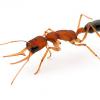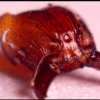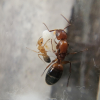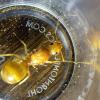Scientific Name: Pheidole obscurithorax
Common Name: Big-Headed Ant
Distribution: Native to Argentina, Brazil, Paraguay, and Uruguay. Introduced to Alabama, Florida, Georgia, Louisiana, Mississippi, and Texas.
Queen size: 7-10mm
Worker size: Minors: 2-4mm. Majors: 5-8mm
Natural Habitat: Open areas, usually with sandy soil.
Circadian Activity: Diurnal and Nocturnal.
Mating Flight: Mostly May-July. Alates leave the nest and mate just before the sun rises and begin landing when the sky starts getting lighter. Mated queens can be found running on the ground in the early morning or in bodies of water. Alates will also fly toward lights, though the vast majority of these tend to be unmated.
Queen Founding Method: Fully-Claustral
Monogyne or Polygyne: Monogyne
Average time from egg to worker: First nanitics emerge after 4-6 weeks. When fed as much as they can eat, a colony can easily surpass 1,000 workers in their first 12 months.
Recommended Temperature: Can be kept at the same temperature throughout the whole year, at around 70-80 Degrees Fahrenheit, or 21-26 Degrees Celsius.
Recommended Humidity: Moderately Humid
Preferred Foods: Mealworms, fruit flies, and most other arthropods. They strongly favor insects or pieces of insects that are small enough to be carried into the nest. A liquid sugar/honey/water mixture or something similar is also necessary to fulfill their carbohydrate needs.
Hibernation Details: Originating from southern South America, they naturally experience a seasonal slowdown during winter months. Therefore, it can benefit them to keep them in the cooler range of 68-73F in the month of January. Brood production may slightly slow down and they may eat less during this time but the colony will ultimately get a bigger egg boost in the spring than if you were to keep their temperature constant throughout the entire year.
Escape Barrier Methods: Fluon/PTFE is very effective on them. I find that one application of fluon can keep them contained for several months before a new layer has to be applied.
Difficulty rating: Easy. Queens go through the founding process with no issues. This species will accept a wide range of foods, even able to kill many types of live prey. They will also accept a wide range of humidity and do not need to be heated if they are kept at room temperature.
Bite and/or Sting rating: Unable to sting, but able to bite. Bites by minors are barely felt and do not hurt at all, while a bite by a major will be very obvious but do not hurt very much.
Special Care or Interesting Notes: This species enjoys protein very much, and are very aggressive when taking down prey. They love to forage and a larger outworld is always better.
Additional Links:
http://www.antwiki.o...e_obscurithorax
https://www.antweb.o...t=allantwebants
http://www.alexander...ole/i-LNC7sr3/A
Information submitted by
Aaron567
Edited by dspdrew, March 5 2022 - 7:49 PM.






















